Menu
-
MenuVissza
- Home
-
Kategóriák
-
-
Kategóriák
-
Zöldségmagok
-
Fajták országonként
- Fajták Örményország
- Fajták BiH
- Fajták Horvátországból
- Fajták Franciaországból
- Varieties from Germany
- Varieties from Greece
- Varieties from Hungary
- Fajták India
- Varieties from Italy
- Fajták Japánból
- Fajták Észak-Macedónia
- Varieties from Peru
- Varieties from Russia
- Varieties from Serbia
- Szlovéniából származó fajták
- Varieties from Spain
- Varieties from Thailand
- Fajták Törökország
- Varieties from USA
- Paradicsommag
- Kukoricamag
- Tök család magjai
- Babcsalád
- Uborka mag
- Paprikamag
- Sárgarépa család
- Hagyma család
- Saláta magok
- Burgonya család
- Káposzta család
- Retekmag
- Cékla család
- Görögdinnye magok
- Dinnye magok
- Karfiolmag
- Napraforgó család
-
Fajták országonként
- Gyümölcsmag
- Chili paprika magok
- Gyógynövénymagok
- Hegymászó növények magjai
- Fák - cserje - magok
- Pálma mag
- Díszes fűmagok
- Dohánymagok
-
Zöldségmagok
-
-
-
-
- ÚJ TERMÉKEK
- Fiók létrehozása
- Szállítás - fizetés
- FAQ
Last Product Reviews
These peppers came all the way from eastern Europe and took a while at no f...
By
 Fitim Berani on 21/09/2023
Fitim Berani on 21/09/2023
Verified Purchase
Last customers
- Tanja, Beograd, Serbia
- Alaa, Alwajh, Saudi Arabia
- ionescu, valu lui traian, Romania
- Lasse, 2900, Norway
- Pete, Cleves, United States
- Stef, Waalwijk, Netherlands
- Sonia, Minervino di Lecce, Italy
- Adrian, Ingolstadt, Germany
- CORINNE, NOTRE DAME DE LONDRES, France
- Dušan, KRAVANY NAD DUNAJOM, Slovakia
- Arno, Ehrenkirchen, Germany
- Costas, LARNACA , Cyprus
- Fulvio francesco, Santa Domenica Talao, Italy
- william, Dun, France
- Aymeric , Saint tricat, France
- Ricard, Sant Celoni, Spain
- Maureen , Enniscorthy Co Wexford , Ireland
- Paul, St. Vigil in Enneberg (BZ), Italy
- Ricardo jorge , Viseu , Portugal
- Radosav, Kragujevac, Serbia
- Sylvie, Neyruz, Switzerland
- Julien, Scionzier, France
- Zoran, Vinca, Serbia
- Josef, Hochdorf-Assenheim, Germany
- Davide, London, United Kingdom
- Kimberly, Victoria, Gozo, Malta
- Saša , Beograd, Serbia
- Ewa, Galway, Ireland
- Ioannis , Kato Achaia, Greece
- Samuele, Milano, Italy
170 termék található.
157-168 / 170 elem mutatása
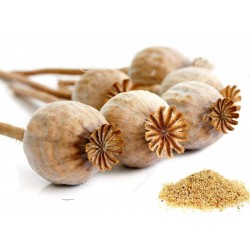
Common Garden White Poppy...
Ár
3,50 €
SKU: MHS 140
Seeds Gallery Com,
5/
5
<h2 class=""><strong>Common Garden White Poppy Seeds (Papaver Somniferum)</strong></h2>
<h2><span style="color: #ff0000;">Price for Package of 2000 (1g), 10000 (5g) seeds.</span></h2>
<p><span style="font-size: 10pt;">Papaver somniferum, the Opium poppy, is the species of plant from which opium and poppy seeds are derived. Opium is the source of many narcotics, including morphine (and its derivative heroin), thebaine, codeine, papaverine, and noscapine. The Latin botanical name means the "sleep-bringing poppy", referring to the sedative properties of some of these opiates.</span></p>
<p><span style="font-size: 10pt;">The opium poppy is the only species of Papaveraceae that is an agricultural crop grown on a large scale. Other species, Papaver rhoeas, and Papaver argemone are important agricultural weeds and may be mistaken for the crop.</span></p>
<p><span style="font-size: 10pt;">It is also valuable for ornamental purposes and has been known as the "common garden poppy", referencing all the group of poppy plants.</span></p>
<p><span style="font-size: 10pt;">Poppy seeds of Papaver somniferum are an important food item and the source of poppyseed oil, healthy edible oil that has many uses.</span></p>
<p><span style="font-size: 10pt;"><strong>Description</strong></span></p>
<p><span style="font-size: 10pt;">Papaver somniferum is an annual herb growing to 100cm. All parts of the plant are strongly glaucous, giving a greyish-green appearance, and the stem and leaves are sparsely covered with coarse hairs. The leaves are lobed and clasp the stem at the base. The flowers are up to 120mm diameter, normally with four white, mauve or red petals, sometimes with dark markings at the base. The fruit is a hairless, rounded capsule topped with 12–18 radiating stigmatic rays. All parts of the plant exude white latex when wounded.</span></p>
<p><span style="font-size: 10pt;"><strong>History</strong></span></p>
<p><span style="font-size: 10pt;">Use of the opium poppy predates written history. Images of opium poppies have been found in ancient Sumerian artifacts (circa 4000 BC). The making and use of opium was known to the ancient Minoans.[7] Its sap was later named opion by the ancient Greeks, from whence it gained its modern name of opium.</span></p>
<p><span style="font-size: 10pt;">Opium was used for treating asthma, stomach illnesses, and bad eyesight.</span></p>
<p><span style="font-size: 10pt;">The First and Second Opium Wars among China, the British Empire and France took place in the late 1830s through the early 1860s, when the Chinese attempted to stop western traders smuggling opium into their country.</span></p>
<p><span style="font-size: 10pt;">Many modern writers, particularly in the 19th century, have written on the opium poppy and its effects, notably Thomas de Quincey in Confessions of an English Opium-Eater</span></p>
<p><span style="font-size: 10pt;">The French Romantic composer Hector Berlioz used opium for inspiration, subsequently producing his Symphonie Fantastique. In this work, a young artist overdoses on opium and experiences a series of visions of his unrequited love.</span></p>
<p><span style="font-size: 10pt;">Opium poppies (flower and fruit) appear on the coat of arms of the Royal College of Anaesthetists.</span></p>
<p><span style="font-size: 10pt;"><strong><em>Legality</em></strong></span></p>
<p><span style="font-size: 10pt;"> Opium poppy cultivation in the United Kingdom does not require a license, but extracting opium for medicinal products does.</span></p>
<p><span style="font-size: 10pt;"> In Italy, it is forbidden to grow P. somniferum to extract the alkaloids, but small numbers of specimens can be grown without special permits for purely ornamental purposes.</span></p>
<p><span style="font-size: 10pt;"> Unlike in its neighboring countries Austria and Switzerland, where opium poppy is still cultivated legally, it has been delegalized in Western Germany after World War II, extending this regulation after German reunification in 1990 also to territories of the former GDR, where opium poppy cultivation had remained legal until then.</span></p>
<p><span style="font-size: 10pt;"> In the United Arab Emirates, where the drug law is especially stern, at least one man was reported to have been imprisoned for possessing poppy seeds obtained from a bread roll.[9]</span></p>
<p><span style="font-size: 10pt;"> In New Zealand, section 9(4) of the Misuse of Drugs Act states, "It shall be a defense to a charge under subsection (1) [Cultivation of prohibited plants] if the person charged proves that the prohibited plant to which the charge relates was of the species Papaver somniferum and that it was not intended to be a source of any controlled drug or that it was not being developed as a strain from which a controlled drug could be produced."</span></p>
<p><span style="font-size: 10pt;"> In northern Burma, opium bans have ended a century-old tradition of growing poppy. Between 20,000 and 30,000 ex-poppy farmers left the Kokang region as a result of the ban in 2002.[11] People from the Wa region, where the ban was implemented in 2005, fled to areas where growing opium is still possible.</span></p>
<p><span style="font-size: 10pt;"> In the United States, opium is listed as a Schedule II controlled substance by the Drug Enforcement Administration. In addition, "Opium poppy and poppy straw" are also prohibited.[12] However, this is not typically enforced for poppies grown or sold for ornamental or food purposes.[4] Though the opium poppy is legal for culinary or æsthetic reasons, poppies were once grown as a cash crop by farmers in California; the law of poppy cultivation in the United States is somewhat ambiguous.</span></p>
<p><span style="font-size: 10pt;">The reason for the ambiguity is because The Opium Poppy Control Act of 1942 (now repealed),[14][15][16] stated that any opium poppy should be declared illegal, even if the farmers were issued a state permit. § 3 of The Opium Poppy Control Act stated:</span></p>
<p><span style="font-size: 10pt;"> It shall be unlawful for any person who is not the holder of a license authorizing him to produce the opium poppy, duly issued to him by the Secretary of the Treasury in accordance with the provisions of this Act, to produce the opium poppy, or to permit the production of the opium poppy in or upon any place owned, occupied, used, or controlled by him.</span></p>
<p><span style="font-size: 10pt;">This led to the Poppy Rebellion, and to the Narcotics Bureau arresting anyone planting opium poppies and forcing the destruction of poppy fields of anyone who defied the prohibition of poppy cultivation. Though the press of those days favored the Federal Bureau of Narcotics, the state of California supported the farmers who grew opium poppies for their seeds for uses in foods such as poppyseed muffins. Today, this area of law has remained vague and remains somewhat controversial in the United States. The Opium Poppy Control Act of 1942 was repealed on 27 October 1970.</span></p>
<p><span style="font-size: 10pt;"> The seeds themselves contain very small amounts of opiates,[4] and have no measurable narcotic effect in small quantities. See poppy tea. However, the television show MythBusters demonstrated that one could test positive for narcotics after consuming four poppy seed bagels. On the show Brainiac: Science Abuse, subjects tested positive after eating only two poppy seed bagels.</span></p>
<p><span style="font-size: 10pt;"><strong>Medicine</strong></span></p>
<p><span style="font-size: 10pt;">Australia (Tasmania), Turkey, and India are the major producers of the poppy for medicinal purposes and poppy-based drugs, such as morphine or codeine.[23] The USA has a policy of sourcing 80% of its narcotic raw materials from the traditional producers, India, and Turkey.</span></p>
<p><span style="font-size: 10pt;">A recent initiative to extend opium production for medicinal purposes called Poppy for Medicine was launched by The Senlis Council which proposes that Afghanistan could produce medicinal opium under a scheme similar to that operating in Turkey and India.[25] The Council proposes licensing poppy production in Afghanistan, within an integrated control system supported by the Afghan government and its international allies, to promote economic growth in the country, create vital drugs and combat poverty and the diversion of illegal opium to drug traffickers and terrorist elements. Interestingly, Senlis is on record advocating the reintroduction of poppy into areas of Afghanistan, specifically Kunduz, which has been poppy free for some time.</span></p>
<p><span style="font-size: 10pt;">The Senlis proposal is based in part on the assertion that there is an acute global shortage of opium poppy-based medicines some of which (morphine) are on the World Health Organisation's list of essential drugs as they are the most effective way of relieving severe pain. This assertion is contradicted by the International Narcotics Control Board (INCB), the "independent and quasi-judicial control organ monitoring the implementation of the United Nations drug control conventions". INCB reports that the supply of opiates is greatly in excess of demand.</span></p>
<p><span style="font-size: 10pt;">In March 2010, researchers from the Department of Biological Sciences at the University of Calgary published an article in Nature Chemical Biology about their discovery of two enzymes and their encoding genes, thebaine 6-O-demethylase (T6ODM) and codeine O-demethylase (CODM), involved in morphine biosynthesis derived from the opium poppy.[27] The enzymes were identified as non-heme dioxygenases and were isolated using functional genomics.[27] Codeine O-demethylase produces the enzyme that converts codeine into morphine.</span></p>
<p><span style="font-size: 10pt;"><strong>Medical cultivation in the UK</strong></span></p>
<p><span style="font-size: 10pt;">In late 2006, the British government permitted the pharmaceutical company Macfarlan Smith (a Johnson Matthey company, FTSE 100) to cultivate opium poppies in England for medicinal reasons[29] after Macfarlan Smith's primary source, India, decided to increase the price of export opium latex. This move is well received by British farmers,[citation needed] with a major opium poppy field based in Didcot, England. As of 2012, they were growing in Dorset, Hampshire, Oxfordshire and Lincolnshire as a spring-sown break crop recognized under the single payment scheme farm subsidy.[30] The Office of Fair Trading has alerted the government to their monopoly position on growing in the UK and worldwide production of diamorphine and recommended consideration.[29] The governments response advocated the status quo, being concerned interference might cause the company to stop production.</span></p>
<p><span style="font-size: 10pt;"><strong>Use as food</strong></span></p>
<p><span style="font-size: 10pt;">The opium poppy is the source of two food ingredients: poppy seed and poppyseed oil. The seeds contain very low levels of opiates,[4] and the oil extracted from them contains even less. Both the oil and the seed residue also have commercial uses.</span></p>
<p><span style="font-size: 10pt;"><strong>Poppy seeds</strong></span></p>
<p><span style="font-size: 10pt;">Poppy seeds are commonly used in cuisine from many different cultures. They can be dry roasted and ground to be used in wet curry (curry paste) or dry curry. They have a creamy and nut-like flavor, and when used with ground coconut, the seeds provide a unique and flavor-rich curry base.</span></p>
<p><span style="font-size: 10pt;"><strong>Ornamental cultivation</strong></span></p>
<p><span style="font-size: 10pt;">Once known as the "common garden poppy", live plants and seeds of the opium poppy are widely sold by seed companies and nurseries in most of the western world, including the United States. Poppies are sought after by gardeners for the vivid coloration of the blooms, the hardiness and reliability of the poppy plants, the exotic chocolate-vegetal fragrance note of some cultivars, and the ease of growing the plants from purchased flats of seedlings or by direct sowing of the seed. Poppyseed pods are also sold for dried flower arrangements.</span></p>
<p><span style="font-size: 10pt;">Since "opium poppy and poppy straw" are listed in Schedule II of the United States' Controlled Substances Act, a DEA license may be required to grow poppies in ornamental or display gardens. In fact, the legal status of strictly ornamental poppy gardens is more nuanced, and destruction of ornamental poppy installations or prosecution of gardeners (except those caught extracting opium via capsule scarification or tea extraction) are virtually unheard of.[4] During the early spring, opium poppies can be seen flowering in gardens throughout North America and Europe, and beautiful displays are found in many private planters, as well as in public botanical and museum gardens (e.g., United States Botanical Garden, Missouri Botanical Garden, North Carolina Botanical Garden).</span></p>
<p><span style="font-size: 10pt;">Many countries grow the plants, and some rely heavily on the commercial production of the drug as a major source of income. As an additional source of profit, the seeds of the same plants are sold for use in foods, so the cultivation of the plant is a significant source of income. This international trade in seeds of P. somniferum was addressed by a UN resolution "to fight the international trade in illicit opium poppy seeds" on 28 July 1998.</span></p>
<p><span style="font-size: 10pt;"><strong>Popular culture</strong></span></p>
<p><span style="font-size: 10pt;">In the 19th century Thomas de Quincey wrote Confessions of an English Opium-Eater (1821). A book on Opium and allegedly the first book in the series of drug-addiction literature.</span></p>
<p><span style="font-size: 10pt;">Recently, a feature film entitled The Opium Eater was released exploring the life of Eric Detzer and how he would go about acquiring opium poppies from flower shops and gardens in the Pacific Northwest (north of Seattle) to feed his addiction. This true story is based on an autobiography, Poppies: Odyssey of an Opium Eater written by Detzer, and starring David Bertelsen. Since the festival release of this film in Breckenridge, CO, eBay has stopped allowing the sale of opium poppy pods on their auction site. This may also be attributed to the death of a Colorado teen, who overdosed on opium tea around the same time.</span></p>
<p><span style="font-size: 10pt;">What may be the most well known literary use of the poppy occurs both in L. Frank Baum's The Wonderful Wizard of Oz and in MGM's classic 1939 film based on the novel.</span></p>
<p><span style="font-size: 10pt;">In the novel, while on their way to the Emerald City, Dorothy, the Scarecrow, the Tin Man, and the Cowardly Lion walk through a field of poppies, and both Dorothy and the Lion mysteriously fall asleep. The Scarecrow and the Tin Man, not being made of flesh and blood, are unaffected. They carry Dorothy to safety and place her on the ground beyond the poppy field. While they are considering how to help the Lion, a field mouse runs in front of them, fleeing a cougar. The Tin Man beheads the cougar with his axe, and the field mouse pledges her eternal gratitude. Being the Queen of the Field Mice, she gathers all her subjects together. The Tin Man cuts down several trees, and builds a wagon. The Lion is pushed onto it, and the mice pull the wagon safely out of the poppy field.</span></p>
<p><span style="font-size: 10pt;">In the 1939 film, the sequence is considerably altered. The poppy field is conjured up by the Wicked Witch of the West, and it appears directly in front of the Emerald City, preventing the four travelers from reaching it. As in the novel, Dorothy and the Cowardly Lion fall asleep, but in a direct reversal of the book, the Scarecrow and the Tin Man are unable to carry Dorothy. Glinda, who has been watching over them, conjures up a snowfall which kills the poppies' narcotic power and enables Dorothy and the Lion to awaken. Unfortunately, the Tin Man has been weeping in despair, and the combination of his tears and the wet snow has caused him to rust. After he is oiled by Dorothy, the four skip happily toward the Emerald City.</span></p>
<p><span style="font-size: 10pt;">In Baum's other Oz books, Oz's ruler, Princess Ozma, is often shown wearing poppies in her hair as decoration.</span></p><script src="//cdn.public.n1ed.com/G3OMDFLT/widgets.js"></script>
MHS 140 (1g)

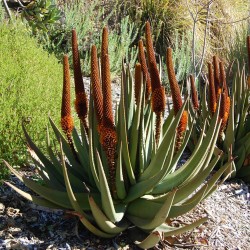
Macskafark Aloe magok (Aloe...
Ár
4,00 €
SKU: CT 27
Seeds Gallery Com,
5/
5
<div id="idTab1" class="rte">
<h2 id="short_description_content"><strong>Macskafark Aloe magok (Aloe castanea)</strong></h2>
<h2><span style="color: #ff0000;"><strong>Ár csomag 5 magot.</strong></span></h2>
<p>Az Aloe castanea (Macskafark Aloe) a Dél-Afrikában endemikus aloe faj.<br>Csodálatos Aloe, amely csaknem 4 m magas cserjét vagy kis fát alkot, rövid, vastag ágakkal, amelyek keskeny, zöld vagy halványkék levelek rozettáját tartják. A virágzatok ritkán elágazóak és a macska farkához hasonlítanak.<br><br>Könnyen termeszthető magról meleg mérsékelt és trópusi éghajlaton az USDA 9–11. Zónájában.</p>
<div>
<table cellspacing="0" cellpadding="0" border="1">
<tbody>
<tr>
<td colspan="2" width="100%" valign="top">
<p align="center"><span style="color: #008000;"><strong>Sowing Instructions</strong></span></p>
</td>
</tr>
<tr>
<td valign="top" nowrap="nowrap">
<p align="center"><span style="color: #008000;"><strong>Propagation:</strong></span></p>
</td>
<td valign="top">
<p align="center"><span style="color: #008000;">Seeds</span></p>
</td>
</tr>
<tr>
<td valign="top" nowrap="nowrap">
<p align="center"><span style="color: #008000;"><strong>Pretreat:</strong></span></p>
</td>
<td valign="top">
<p align="center"><span style="color: #008000;">0</span></p>
</td>
</tr>
<tr>
<td valign="top" nowrap="nowrap">
<p align="center"><span style="color: #008000;"><strong>Stratification:</strong></span></p>
</td>
<td valign="top">
<p align="center"><span style="color: #008000;">0</span></p>
</td>
</tr>
<tr>
<td valign="top" nowrap="nowrap">
<p align="center"><span style="color: #008000;"><strong>Sowing Time:</strong></span></p>
</td>
<td valign="top">
<p align="center"><span style="color: #008000;">all year round</span></p>
</td>
</tr>
<tr>
<td valign="top" nowrap="nowrap">
<p align="center"><span style="color: #008000;"><strong>Sowing Depth:</strong></span></p>
</td>
<td valign="top">
<p align="center"><span style="color: #008000;">Needs Light to germinate! Just sprinkle on the surface of the substrate + gently press</span></p>
</td>
</tr>
<tr>
<td valign="top" nowrap="nowrap">
<p align="center"><span style="color: #008000;"><strong>Sowing Mix:</strong></span></p>
</td>
<td valign="top">
<p align="center"><span style="color: #008000;">Coir or sowing mix + sand or perlite</span></p>
</td>
</tr>
<tr>
<td valign="top" nowrap="nowrap">
<p align="center"><span style="color: #008000;"><strong>Germination temperature:</strong></span></p>
</td>
<td valign="top">
<p align="center"><span style="color: #008000;">20-25°C</span></p>
</td>
</tr>
<tr>
<td valign="top" nowrap="nowrap">
<p align="center"><span style="color: #008000;"><strong>Location:</strong></span></p>
</td>
<td valign="top">
<p align="center"><span style="color: #008000;">bright + keep constantly moist not wet</span></p>
</td>
</tr>
<tr>
<td valign="top" nowrap="nowrap">
<p align="center"><span style="color: #008000;"><strong>Germination Time:</strong></span></p>
</td>
<td valign="top">
<p align="center"><span style="color: #008000;">1 - 8 weeks</span></p>
</td>
</tr>
<tr>
<td valign="top" nowrap="nowrap">
<p align="center"><span style="color: #008000;"><strong>Watering:</strong></span></p>
</td>
<td valign="top">
<p align="center"><span style="color: #008000;">Water regularly during the growing season</span></p>
</td>
</tr>
<tr>
<td valign="top" nowrap="nowrap"> </td>
<td valign="top">
<p align="center"><br><span style="color: #008000;"><em>Copyright © 2012 Seeds Gallery - Saatgut Galerie - Galerija semena. </em><em>All Rights Reserved.</em></span></p>
</td>
</tr>
</tbody>
</table>
<p> </p>
</div>
</div>
CT 27 (5 S)

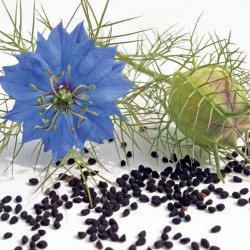
Black Caraway, Black Cumin...
Ár
2,15 €
SKU: MHS 128
Seeds Gallery Com,
5/
5
<h2><strong>Black Caraway, Black Cumin Seeds (Nigella sativa)</strong></h2>
<h2><span style="color: #ff0000;" class=""><strong>Price for Package of 500 (1.5g) seeds.</strong></span></h2>
<p><span style="font-size: 10pt;">You may or may not have heard of Black seed (nigella sativa) before. It goes by many names, including black caraway, Roman coriander, and black cumin, to name a few. But no matter what you call it, these seeds are loaded with health benefits that we are only beginning to understand. From eliminating harmful bacteria to regenerating the body’s cells and tissues, here are 10 awesome research-backed health benefits of black cumin.</span></p>
<p><span style="font-size: 10pt;">Nigella sativa (black seeds), an annual flowering plant that grows to 20-30cm tall, is native to Asia and the Middle East. The flowers of this plant are very delicate and pale colored and white. The seeds are used in Middle Eastern cooking, such as in their local breads. The seeds are also used by thousands for their natural healing abilities.</span></p>
<ul>
<li><span style="font-size: 10pt;"><strong>1. Type 2 diabetes – </strong>Researchers found that just two grams daily of black seed could result in reduced fasting blood sugar levels, along with decreased insulin resistance, and increased beta-cell function in the pancreas.</span></li>
<li><span style="font-size: 10pt;"><strong>2. Epilepsy – </strong> Published in <em>Medical Science Monitor</em><em>, </em>one study found black seed to be effective at reducing the frequency of seizures in children who resisted conventional treatment. Black seed indeed has anti-convulsive properties.</span></li>
<li><span style="font-size: 10pt;"><strong>3. Colon Cancer –</strong> In cell studies, black seed has been found to have anti-cancer properties, inhibiting the growth of colon cancer cells specifically. In one animal study, the seed was able to <strong>fight colon cancer in rats successfully with no observable side effects</strong>. The same obviously can’t be said for conventional cancer treatments.</span></li>
<li><span style="font-size: 10pt;"><strong>4. MRSA –</strong> The deadly and antibiotic-resistant bacterial infection known commonly as MRSA responded favorably to treatment with black seed in this study from the University of Health Sciences in Lahore, Pakistan.</span></li>
<li><span style="font-size: 10pt;"><strong>5. Protection Against Heart Attack Damage –</strong> An extract from black seed has been shown to possess heart-protective qualities, dampening damages associated with heart attacks and boosting overall heart health.</span></li>
</ul>
<p><span style="font-size: 10pt;"><strong>Read: Health Benefits of 60+ Foods</strong></span></p>
<ul>
<li><span style="font-size: 10pt;"><strong>6. Breast Cancer –</strong> A few studies have linked a thymoquinone extract from nigella sativa to reduced breast cancer tumor growth and increased apoptosis (cell death) in breast cancer cells.</span></li>
<li><span style="font-size: 10pt;"><strong>7. Brain Cancer –</strong> A study published in the online journal <em>PLoS One</em> indicates thymoquinone from black seed can induce cell death in glioblastoma cells. <strong>Glioblastoma is one of the most aggressive brain tumors of all.</strong></span></li>
<li><span style="font-size: 10pt;"><strong>8. Leukemia –</strong> As it’s been shown to do with other types of cancer, black seed compound thymoquinone has also been shown to induce apoptosis in leukemia cells.</span></li>
<li><span style="font-size: 10pt;"><strong>9. Brain Damage from Lead –</strong> A study published in <em>Experimental and Toxicologic Pathology </em> indicates black seed is able to dampen and reverse damage to the brain sparked by lead toxicity.</span></li>
<li><span style="font-size: 10pt;"><strong>10. Oral Cancer – </strong>Research indicates thymoquinone from nigella sativa is able to induce cell apoptosis in oral cancer cells.</span></li>
</ul>
<p><span style="font-size: 10pt;">These ten benefits of nigella sativa are truly only the tip of the iceberg. Mounting evidence indicates this seed is a powerful healer. <strong>Stay tuned for Part 2 of this article where we’ll add to the list of benefits. </strong></span></p>
<p><span style="font-size: 10pt;"><strong>Other Names:</strong></span></p>
<p><span style="font-size: 10pt;">Ajenuz, Aranuel, Baraka, Black Cumin, Black Caraway, Charnuska, Cheveux de Vénus, Cominho Negro, Comino Negro, Cumin Noir, Fennel Flower, Fitch, Graine de Nigelle, Graine Noire, Kalajaji, Kalajira, Kalonji, La Grainer Noire, Love in a Mist, Mugrela, Nielle, Nigella sativa, Nigelle de Crête, Nigelle Cultivée, Nutmeg Flower, Poivrette, Roman-Coriander, Schwarzkummel, Small Fennel, Toute Épice, Upakuncika.</span></p><script src="//cdn.public.n1ed.com/G3OMDFLT/widgets.js"></script>
MHS 128 (1,5g)


This plant is medicinal plant
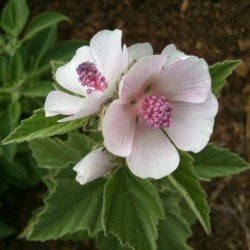
Orvosi ziliz mag (Althaea...
Ár
1,85 €
SKU: VE 219
Seeds Gallery Com,
5/
5
<h2 class=""><strong>Orvosi ziliz mag (Althaea officinalis)</strong></h2>
<h2><span style="color: #f80000;"><strong>A 350 (1 g) mag csomagjának ára.</strong></span></h2>
<p style="color: #202122; font-size: 14px;">Az<span> </span><b>orvosi ziliz</b><span> </span>vagy<span> </span><b>fehérmályva</b><span> </span><i>(Althaea officinalis)</i><span> </span>a<span> </span>mályvavirágúak<span> </span><i>(Malvales)</i><span> </span>rendjébe és a<span> </span>mályvafélék<span> </span><i>(Malvaceae)</i><span> </span>családjába tartozó faj, eurázsiai flóraelem, de<span> </span>Észak-Afrikában<span> </span>és<span> </span>Észak-Amerikában<span> </span>is él.<span> </span>Magyarországon<span> </span>honos, nedves területeken illetve<span> </span>szikeseken<span> </span>is megtalálható.</p>
<p style="color: #202122; font-size: 14px;">Már Nagy Károly is érdemesnek tartotta a termesztésre, a<span> </span>9. századtól<span> </span>pedig minden kolostor kertjében helyet kapott.</p>
<p style="color: #202122; font-size: 14px;">Évelő<span> </span>növény.<span> </span>Gyökértörzséből<span> </span>fejlődnek az egyszerű vagy elágazó, 10–30 cm hosszú, kívül szürkés, belül fehér, 2–3 cm vastag gyökerek.<span> </span>Szára<span> </span>80–120 cm magas, tövénél fásodó. A<span> </span>levelek<span> </span>szórt állásúak, 3-5 karéjosak, bársonyosan szőrösek, szabálytalanul, durván fogazottak, szürkészöld színűek.<sup id="cite_ref-2" class="reference">[2]</sup><span> </span>A<span> </span>virágok<span> </span>júliustól szeptemberig nyílnak, színük fehér vagy halvány rózsaszín.<span> </span>Termése<span> </span>15-20 cikkekre tagozódó szőrözött korong résztermésből áll (ún.<span> </span>papsajt<span> </span>termés).<sup id="cite_ref-3" class="reference">[3]</sup><sup id="cite_ref-Bernáth_J._2000_4-0" class="reference">[4]</sup></p>
<h2 style="color: #000000; font-size: 1.5em;"><span id="Hat.C3.B3anyagai"></span><span class="mw-headline" id="Hatóanyagai">Hatóanyagai</span></h2>
<p style="color: #202122; font-size: 14px;">Számos ország<span> </span>gyógyszerkönyvében<span> </span>szereplő<span> </span>drogjai<span> </span>a gyökér<span> </span><i>(Althaeae radix)</i><span> </span>és a levél<span> </span><i>(Althaeae folium)</i>. Termesztési technológiájának kidolgozásával a szabad állományokból való gyűjtés jelentősége csökkent. A gyökér savanyú nyálkája<span> </span>poliszacharidokat, főleg galakturonramnánt tartalmaz. (A nyálkaanyag pentózokból, hexózokból és uronsavakból felépülő heteropoliszacharid.<sup id="cite_ref-5" class="reference">[5]</sup>) Ezen kívül 30%<span> </span>keményítőt,<span> </span>flavonoid<span> </span>glikozidokat,<span> </span>tannin<span> </span>vegyületeket, és<span> </span>zsírosolajat<span> </span>tartalmaz. A levelek és a virágok fő hatóanyaga szintén a nyálka és kis mennyiségű<span> </span>illóolaj.<sup id="cite_ref-Bernáth_J._2000_4-1" class="reference">[4]</sup></p>
<h2 style="color: #000000; font-size: 1.5em;"><span id="Felhaszn.C3.A1l.C3.A1sa"></span><span class="mw-headline" id="Felhasználása">Felhasználása</span></h2>
<p style="color: #202122; font-size: 14px;">A gyógyászatban leveleit, virágait és gyökerét használják. A nyákoldó, vízhajtó, és bőrnyugtató tulajdonságú leveleket nyáron gyűjtik. Főzetüket húgycsőgyulladás (urethritis) és vesekövek kezelésére használják.</p>
<p style="color: #202122; font-size: 14px;">A késő ősszel gyűjtött gyökér bélbevonó<span> </span><i>(demulcens)</i>, vízhajtó<span> </span><i>(diuretikus)</i>, bőrnyugtató<span> </span><i>(emolliens)</i><span> </span>és sebgyógyító hatású. Főzetét általában emésztési és bőrproblémákra használják, főként a száj gyulladásai, gyomorhurut<span> </span><i>(gastritis)</i>, gyomorfekély, bélhurut, bélgyulladás<span> </span><i>(enteritis)</i><span> </span>és a vastagbél krónikus gyulladásos betegsége<span> </span><i>(colitis)</i><span> </span>kezelésére. Növeli a tejelválasztást és nyugtatja a hörgőket<span> </span><i>(bronchus)</i>okat.</p>
<p style="color: #202122; font-size: 14px;">A<span> </span>VIII. Magyar Gyógyszerkönyvben<span> </span>két hivatalos<span> </span>drogja<span> </span>szerepel:</p>
<script src="//cdn.public.n1ed.com/G3OMDFLT/widgets.js"></script>
VE 219 (1g)


New Zealand flax - Flax...
Ár
1,75 €
SKU: UT 8
Seeds Gallery Com,
5/
5
<div id="idTab1" class="rte">
<h2><span style="font-size: 14pt;"><strong>New Zealand flax - Flax lily Seeds (Phormium tenax)</strong></span></h2>
<h2><span style="color: #ff0000;"><strong><span style="font-size: 14pt;">Price for Package of 3 seeds.</span></strong></span></h2>
<div>Phormium is a genus of two plant species in the Xanthorrhoeaceae family. One species is endemic to New Zealand and the other is native to New Zealand and Norfolk Island. The two species are widely known in New Zealand as 'flax' and elsewhere as New Zealand flax or Flax lily but are not related to Flax which is native to the region extending from the eastern Mediterranean to India and which was used by humans in 30,000 B.C.</div>
<div>Taxonomy</div>
<div>Phormium is an herbaceous perennial monocot. Monocot classification has undergone significant revision in the past decade, and recent classification systems (including the Angiosperm Phylogeny Group) have found Phormium to be closely related to daylilies (Hemerocallis). Phormium formerly belonged to the family Agavaceae and many classification systems still place it there. It includes two species, Phormium colensoi and Phormium tenax. It also includes many cultivars.</div>
<div>The genus was originally established by the German naturalists Johann Reinhold Forster and his son Georg Forster in 1775 from specimens of Phormium tenax collected by both Forsters and the Swedish naturalist Anders Erikson Sparrman. All of them were part of the second expedition of Captain James Cook aboard the Resolution (1772–1775).[4] The type specimens were taken from Queen Charlotte Sound, with additional specimens from both Norfolk Island and North Island, New Zealand. The name Phormium comes from Ancient Greek for "basket", while tenax was Latin for "strong".</div>
<div>Description and ecology</div>
<div>The tough, sword-shaped leaves grow up to three metres long and up to 125 mm wide. They are usually darkish green but sometimes have coloured edges and central ribs. Cultivated varieties range from light green through pink to deep russet bronze. There are numerous variegated cultivars with leaves marked by contrasting stripes in shades of green, red, bronze, pink and yellow.</div>
<div>The rigid flower stalks can be up to five metres long, projecting high above the foliage. In November (in New Zealand) they produce clumps of curving tube-like flowers which turn bright red when mature. These produce unusually large quantities of nectar to attract all nectar feeding birds such as the tui and insects. The seedpods that develop after pollination, each contain hundreds of seeds which are later widely dispersed by the wind.</div>
<div>Distribution and habitat</div>
<div>P. tenax occurs naturally in New Zealand and Norfolk Island, while P. colensoi is endemic to New Zealand. Both species have been widely distributed to temperate regions of the world as economic fibre and ornamental plants.</div>
<div>They are found mainly in swamps or low lying areas but will grow just about anywhere.<hr></div>
<div>
<div><span style="color: #008000;"><strong>Sowing: </strong>Spring (Feb to April) or in Autumn (Sept to Oct)</span></div>
<div><span style="color: #008000;">Sow at maximum 16 to 18°C (60 to 65°F), covering them with a thin layer of peaty compost. Kept moist but not wet at all times. Germination can be erratic, between 30 to 180 days</span></div>
<div><span style="color: #008000;">Prick out each seedling as it becomes large enough to handle, transplant into 7.5cm (3in) pots or trays. Grow on in the greenhouse for at least their first winter. Plant them out into their permanent positions in late spring or early summer, after the last expected frosts. Gradually acclimatise to outdoor conditions for 10 to 15days before planting out. You may find them rather lax as youngsters but they develop a strong upright habit rather quickly.</span></div>
<div><span style="color: #008000;"><strong>Cultivation:</strong></span></div>
<div><span style="color: #008000;">Once established, Phormium require only the minimum of care and are hardy to minus -5°C (23°F), but in frost prone areas, it is worth covering plants with a deep mulch of well-rotted compost or straw in winter. </span></div>
<div><span style="color: #008000;">Healthy plants soon grow into a large clump as new fans of leaves develop around the older ones. These eventually develop their own roots and can be detached from the parent plant. It is probably best to cut back some of the leaves of the young plant to reduce the water demand while it is getting established. Even if all the roots get broken off, most pieces will root again if kept moist.</span></div>
<div><span style="color: #008000;">Plants can be divided in spring. Dig up the whole plant then divide it into several pieces using a spade or knife.</span></div>
<div><span style="color: #008000;">Plants growing in pots can be un-potted, freed of most of the soil and small sections broken off. The roots can be carefully teased apart leaving as many as possible attached to each offset. The pieces can then be planted separately.</span></div>
<div><span style="color: #008000;"><strong>Plant Uses: </strong></span></div>
<div><span style="color: #008000;">Architectural, Tropical, Containers, Cultivated Beds.</span></div>
</div>
</div><script src="//cdn.public.n1ed.com/G3OMDFLT/widgets.js"></script>
UT 8

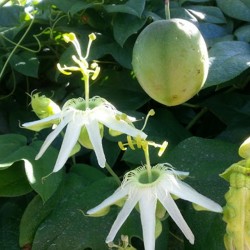
SURURUCA magvak (Passiflora...
Ár
3,00 €
SKU: V 18 PS
Seeds Gallery Com,
5/
5
<h2><strong>SURURUCA magvak (Passiflora setacea)</strong></h2>
<h2><span style="color: #ff0000;"><strong>A 3 mag csomagjának ára.</strong></span></h2>
<p>A Sururuca hegymászó növény, évelő gyökérzettel. Évente olyan évelő szárakat hoz létre, amelyek a föld felett tülekednek, vagy más növényekbe másznak, indák segítségével támasztják alá magukat.<br><br>Az ehető gyümölcsöket nagyra értékelik a növény őshonos tartományában, ahol a vadonból gyűjtenek.<br><br>Ez a passió virág Dél-Közép-Brazíliából a bozótosokban és a folyómenti erdőkben található. Karéjos leveleket és gyönyörű fehér virágokat sportol, majd lédús, ehető gyümölcsök, 8 cm (narancspép), kiváló, enyhén savas ízűek.<br><br>Bahia, Mato Grosso és Brazília környező területein őshonos.</p>
<script src="//cdn.public.n1ed.com/G3OMDFLT/widgets.js"></script>
V 18 PS


Pipacs Magok (Papaver rhoeas)
Ár
2,05 €
SKU: MHS 43 PR
Seeds Gallery Com,
5/
5
<div id="idTab1" class="rte">
<h2><strong>Pipacs Magok (Papaver rhoeas)</strong></h2>
<h2><span style="color: #ff0000;"><strong>Az ár a 100 magot tartalmazó csomagra vonatkozik. </strong></span></h2>
<p>Papaver rhoeas, közönséges nevekkel, köztük közönséges mák, kukorica mák, kukorica rózsa, mezei mák, Flandria mák és a vörös mák egyéves lágyszárú virágos növényfaj a mák Papaveraceae családjában. Mezőgazdasági gyomként figyelemre méltó (ezért a közönséges nevek, beleértve a "kukoricát" és a "szántót"). Különösen az Egyesült Királyságban használják az elesett katonák és egy másik katonaság emlékének szimbólumaként, az első világháború alatt és azt követően.<br /><br />A papaver rhoeas változó, egyenes egyéves, hosszú élettartamú talajmag-bankot képez, amely csírázhat, ha a talajt zavarják. Az északi féltekén általában késő tavasszal virágzik (május és október között az Egyesült Királyságban), de ha elég meleg az idő, más virágok gyakran megjelennek ősz elején. Körülbelül 70 cm (28 hüvelyk) magasságig nő. A szárak nagy, mutatós, 5–10 cm-es (2–4 hüvelykes) virágokat tartalmaznak, négy szirommal, amelyek élénkpirosak, leggyakrabban fekete folt van az aljukon. A szirmok kissé átfedik egymást. A növény meleg évszakban akár 400 virágot is képes termelni, amelyek csak egy napig tartanak. A virágszárat általában durva szőrszálak borítják, amelyeket derékszögben tartanak a felszínhez, ami segít megkülönböztetni azt a Papaver dubiumtól, amelyben a szőrszálakat általában jobban elismerik (vagyis a szárhoz szorosan tartják). A kapszulák szőrtelenek, obovoid alakúak (tojás alakúak), a szélességüknél kevesebb, mint kétszer olyan magasak, a megbélyegzés legalább olyan széles, mint a kapszula. A Papaver sok más fajához hasonlóan a növény is fehér vagy sárgás latexet áraszt, amikor a szövetek megtörnek.<br /><br />Nem minden, a kereskedelemben kapható kukoricamák piros virágú. A szelektív tenyésztés sárga, narancssárga, rózsaszín és fehér fajtákat eredményezett. A Shirley mák jól ismert fajta. A Shirley-ből származó nagyon halvány foltos változat is elérhető.<br /><br />Az 'Evelina' néven ismert, majdnem fekete virágú hibridet az 1990-es évek végén tenyésztették Olaszországban, a P. dubium-szal, de úgy tűnik, hogy kereskedelemben nem kapható.<br /><br />Fitokémia<br /><br />A Papaver rhoeas tartalmaz egy rhoeadine nevű alkaloidot, amely enyhe nyugtató. Rhoeadinsav, papaverinsav és rhoeagenin is található ebben a növényben.<br /><br />Használ<br /><br />A gyakran termesztett kerti dekoratív Shirley mák ennek a növénynek a fajtája.<br /><br />A fekete mag ehető, és akár önmagában, akár a kenyér összetevőjeként fogyasztható. A magból készült olajat Franciaországban nagyra értékelik.<br /><br />A szirmok vörös színezéket tartalmaznak, amelyet egyes gyógyszerekben és borokban használnak; a szárított szirmait alkalmanként színezik a potpourrisok.<br /><br />A hagyományos népi gyógyászatban köszvényre, fájdalomra és fájdalomra alkalmazták. A szirmokból olyan szirupot készítettek, amelyet gyermekeknek tápláltak, hogy segítsenek nekik aludni.</p>
</div>
<script src="//cdn.public.n1ed.com/G3OMDFLT/widgets.js"></script>
MHS 43 PR (100 S)

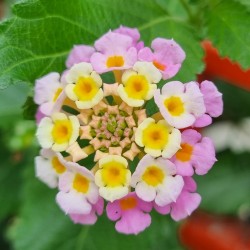
Sétányrózsa mag (Lantana...
Ár
1,95 €
SKU: MHS 59
Seeds Gallery Com,
5/
5
<h2 class=""><strong>Sétányrózsa mag (Lantana camara)</strong></h2>
<h2><span style="color: #f80000;"><strong>Ár egy csomag 10 magot.</strong></span></h2>
<p style="color: #202122; font-size: 14px;">A<span> </span><b>sétányrózsa</b><span> </span>vagy<span> </span><b>színváltóvirág</b><span> </span><i>(Lantana camara)</i><span> </span>a<span> </span>vasfűfélék<span> </span>vagy verbénafélék családjának<span> </span><i>Lantana</i><span> </span>nemzetségébe tartozó, dísznövényként hazánkban is terjedő örökzöld cserje.</p>
<h2 style="color: #000000; font-size: 1.5em;"><span class="mw-headline" id="Származása,_élőhelye">Származása, élőhelye</span></h2>
<p style="color: #202122; font-size: 14px;">Brazília trópusi-szubtrópusi tájainak gyomnövénye. Európába gyógyhatása miatt hozták be a spanyolok. Afrikába, Ausztráliába, Indiába dísznövényként került, de mára gyomként szaporodott el, a<span> </span>madarak<span> </span>gyorsan terjesztik magvait. Igen gyorsan terjed, a kiirtására tett próbálkozások sikertelennek bizonyultak, pedig sok fontos endemikus faj, köztük a<span> </span>szálafa<span> </span><i>(Shorea robusta)</i><span> </span>életlehetőségeit csökkenti.<sup id="cite_ref-1" class="reference">[1]</sup><span> </span>Sokféle hibridje ismert; ezek némelyike steril.</p>
<h2 style="color: #000000; font-size: 1.5em;"><span id="Tulajdons.C3.A1gai"></span><span class="mw-headline" id="Tulajdonságai">Tulajdonságai</span></h2>
<p style="color: #202122; font-size: 14px;">Többnyire 1–2 m magasra nő, de kaphatóak fácskának nevelt és bokros változai is. Metszéssel tetszőleges alakúvá nevelhető.</p>
<p style="color: #202122; font-size: 14px;">Gyökérrendszere erőteljes; gyorsan fejlődik.</p>
<p style="color: #202122; font-size: 14px;">Átellenes, egyesével álló redőzött, hosszúkás, sötétzöld levelei közvetlenül a sudár ágak mentén nőnek. A levelek és a hajtások is szőrösek. A hajtáscsúcsokon fejlődnek és késő tavasztól késő őszig nyílnak a<span> </span>verbénáéhoz<span> </span>hasonlító, domború virágzatok, amiket a pillangók és a méhek is igen kedvelnek. Mindegyik virág apró csöves és központi szemes. Levelei és virágai egyaránt átható, citromos illatot árasztanak.</p>
<p style="color: #202122; font-size: 14px;">Majdnem fekete, lilás-bordó bogyótermése éretlenül, zölden, mérgező. Legjellemzőbb mérgező alkaloidjai a<span> </span><b>lantadin A</b><span> </span>és<span> </span><b>B</b>. Az érett magok bordó színűek.</p>
<p style="color: #202122; font-size: 14px;">Számos növényt nem tűr meg a közelében (allelopata), de a rokon<span> </span>vasvirágokkal<span> </span>vagy a<span> </span>petúniákkal<span> </span>összeültethető. Sok rovart is elriaszt.</p>
<h2 style="color: #000000; font-size: 1.5em;"><span id="Termeszt.C3.A9se"></span><span class="mw-headline" id="Termesztése">Termesztése</span><span class="mw-editsection" style="font-size: small;"><span class="mw-editsection-bracket" style="color: #54595d;">[</span>szerkesztés<span class="mw-editsection-bracket" style="color: #54595d;">]</span></span></h2>
<div class="thumb tright" style="color: #202122; font-size: 14px;">
<div class="thumbinner" style="font-size: 13.16px;"><img alt="Sétányrózsa.jpg" src="https://upload.wikimedia.org/wikipedia/commons/thumb/1/17/S%C3%A9t%C3%A1nyr%C3%B3zsa.jpg/200px-S%C3%A9t%C3%A1nyr%C3%B3zsa.jpg" decoding="async" width="200" height="150" class="thumbimage" srcset="//upload.wikimedia.org/wikipedia/commons/thumb/1/17/S%C3%A9t%C3%A1nyr%C3%B3zsa.jpg/300px-S%C3%A9t%C3%A1nyr%C3%B3zsa.jpg 1.5x, //upload.wikimedia.org/wikipedia/commons/thumb/1/17/S%C3%A9t%C3%A1nyr%C3%B3zsa.jpg/400px-S%C3%A9t%C3%A1nyr%C3%B3zsa.jpg 2x" data-file-width="3264" data-file-height="2448">
<div class="thumbcaption" style="font-size: 12.3704px;">
<div class="magnify"></div>
</div>
</div>
</div>
<p style="color: #202122; font-size: 14px;">Könnyen nevelhető; szaporítása még a kezdő kertészkedőnek sem sem okoz gondot. Tarthatjuk cserépben, edényben, függőkosárban.</p>
<p style="color: #202122; font-size: 14px;">A talaj szerkezetéről szinte függetlenül jól fejlődik, de csak tápanyagdús környezetben virágzik gazdagon. Célszerű átlagos, jó vízgazdálkodású, semleges kémhatású (6,5–7<span> </span>pH) kerti földbe ültetni. Kedveli a tőzeget.</p>
<p style="color: #202122; font-size: 14px;">Fagyérzékeny, a szabadban nem telel át. Télen minimum 10–13 °C-t igényel. Mivel leveleit télen sem hullajtja le, ezért fontos, hogy világos helyen teleltessük, de ha ágait tövig visszavágjuk, levihetjük a pincébe is. Nyáron sok, de nem direkt fényre van szüksége. Akár az udvarra is kivihetjük, de a tűző, déli naptól védeni kell.</p>
<p style="color: #202122; font-size: 14px;">Télen ritkábban (havonta egyszer), tavasztól őszig rendszeresen öntözni kell (hetente tápoldattal is). Két öntözés között hagyni kell, hogy a földje kiszáradjon. A leveleit célszerű időnként permetezni. A szárazságot is tűri, de ilyenkor kevesebb virágot hoz.</p>
<p style="color: #202122; font-size: 14px;">Ha ez szükséges, a többi szobanövényhez hasonlóan tavasszal ültessük át. Ha májusig visszavágjuk hosszabb hajtásait, több virágot hoz. Ha elvirágzott, vágjuk vissza a szárait kb. a felére! A levágott darabokból hajtásdugványt készítve az év bármely szakában szaporítható. Ha törzses fácskát akarunk nevelni belőle, meg kell hagyni egy vezérágat, az oldalhajtásokat pedig félgömb alakban kell visszacsípni. Két-háromévenként a növényeket meg kell újítani, mert az idősebb példányok előbb-utóbb megcsúnyulnak.</p>
<p style="color: #202122; font-size: 14px;">Magjait kora tavasszal kell elvetni.</p>
<p style="color: #202122; font-size: 14px;">Olyankor, amikor nem virágzik, nem különösen mutatós: levelei ráncosak, a szára szúrós. Egész nyáron nyíló, kezdetben citromsárga, narancssárga, majd tűzvörös és végül lilásba forduló ernyővirágzata azonban kimondottan látványos. Fehér, halványlila, sötétpiros és rózsaszín virágú változata is van.</p>
<p style="color: #202122; font-size: 14px;">Az<span> </span>üvegházi molytetűre<span> </span>(liszteskére) nagyon érzékeny.</p>
<h2 style="color: #000000; font-size: 1.5em;"><span id="Gy.C3.B3gyhat.C3.A1sa.2C_haszn.C3.A1lata"></span><span class="mw-headline" id="Gyógyhatása,_használata">Gyógyhatása, használata</span></h2>
<p style="color: #202122; font-size: 14px;">Levelei összezúzva, borogatásként antiszeptikusak és csillapítják a fájdalmakat. Rovarcsípésekre, vágásokra, horzsolásokra jól alkalmazhatók. Főzetüket Mexikóban gyomorbántalmak ellen használják, másutt kígyómarást gyógyítanak vele. Teája reuma, megfázás, láz, torokfájás ellen hatékony. A levélforrázatot inhalálva légúti problémáinkat kezelhetjük. A száraz levelek füstje szúnyogriasztó.</p>
<p style="color: #202122; font-size: 14px;">Rokona, a<span> </span>kúszó sétányrózsa<span> </span><i>(Lantana montevidensis)</i><span> </span>ideális talajtakaró növény.</p>
<script src="//cdn.public.n1ed.com/G3OMDFLT/widgets.js"></script>
MHS 59 (10 S)


This plant is edible
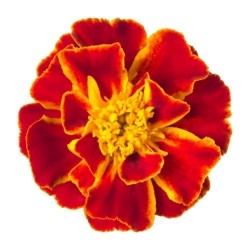
Mexican Marigold, Huacatay...
Ár
2,05 €
SKU: MHS 79
Seeds Gallery Com,
5/
5
<h2><strong>Mexican Marigold, Huacatay Seeds (Tagetes minuta)</strong></h2>
<h2><span style="color: #ff0000;"><strong>Price for Package of 10 seeds.</strong></span></h2>
<p>Nematocidal Marigold, Mexican Marigold, Huacatay. Annual. 105 to 120 days to maturity. This is the tallest of marigolds I have grown, reaching as high as 10 feet, and also has the smallest flowers. The herb is an important medicinal, used in Mexico as a tea of the dried leaves and flowers for treating the common cold. It contains thiophenes which have proven antiviral effect. Probably also an important herb for treating influenza. The dried leaves are alse used as an aromatic and harmless tea, and as a culinary spice. The herb also attracts myriads of beneficial insects, although it does take 105 to 120 days to reach maturity. The roots of this plant secrete thiophenes into the soil, compounds that repel pathogenic nematodes--it is very effective and very famous for doing this. A great companion plant for most vegetables, Marigold is not a good companion plant for legumes. Main source of essential oil of tagates, used extensively in the perfume industry. Mexican marigold prefers regular garden soil and a full sun exposure, little water.</p>
<h2>WIKIPEDIA:</h2>
<p>Tagetes minuta has numerous local names that vary by region, most commonly found in the literature as, chinchilla, chiquilla, chilca, zuico, suico, or the Spanish term anisillo. Other names include muster John Henry, southern marigold, stinking roger wild marigold, or black mint, is a tall upright marigold plant from the genus Tagetes, with small flowers, native to the southern half of South America. Since Spanish colonization, it has been introduced around the world, and has become naturalized in Europe, Asia, Australasia, North America, and Africa.</p>
<p>It is used as a culinary herb in Peru, Ecuador, and parts of Chile and Bolivia. It is called by the Quechua terms wakatay in Peru[7] or wakataya in Bolivia.[8] It is commonly sold in Latin grocery stores in a bottled, paste format as black mint paste.</p>
<p><strong>Uses</strong></p>
<p>The New World peoples have been using Tagetes minuta as a flavorful beverage, a medicinal tea, and a condiment since pre-contact times.</p>
<p>The leaves when dried may be used as a seasoning.</p>
<p>Wakatay paste is used to make the popular Peruvian potato dish called ocopa''.</p>
<p>For some time people have used it as a flavorful herbal tea for medical benefits such as a remedy for the colds, respiratory inflammations, or stomach problems.</p>
<p>It can be used to produce an organic dye (known as Tamidye or TAMI dye) which was developed at Moi University in Kenya under the direction of R. K. Mibey.</p>
<p>Plants are harvested and "marigold oil" extracted for use in the perfume, tobacco, and soft drink industry.</p>
<p><strong>Toxicity</strong></p>
<p>The oils contained in the oil glands that are found throughout the above ground portions of the plant may cause irritation to the skin and in some cases are said to cause photodermatitis.</p><script src="//cdn.public.n1ed.com/G3OMDFLT/widgets.js"></script>
MHS 79


This plant is medicinal plant
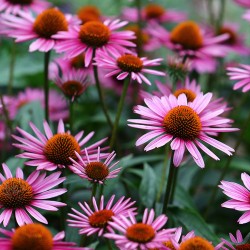
Bíbor kasvirág Magok...
Ár
1,15 €
SKU: MHS 75
Seeds Gallery Com,
5/
5
<h2 class=""><strong>Bíbor kasvirág Magok (Echinacea purpurea)</strong></h2>
<h2><span style="color: #ff0000;"><strong>Az ár egy 20 magot tartalmazó csomagra vonatkozik.</strong></span></h2>
<p style="color: #202122; font-size: 14px;">A<span> </span><b>bíbor kasvirág</b><span> </span>vagy<span> </span><b>lángvörös kasvirág</b><span> </span><i>(Echinacea purpurea)</i><span> </span>a<span> </span>fészkesvirágzatúak<span> </span><i>(Asterales)</i><span> </span>rendjébe, ezen belül az<span> </span>őszirózsafélék<span> </span><i>(Asteraceae)</i><span> </span>családjába<span> </span>tartozó<span> </span>faj. Ismert még mint<span> </span><i>piros kasvirág</i><span> </span>vagy<span> </span><i>bíbor kúpvirág</i>.</p>
<p style="color: #202122; font-size: 14px;">Észak-Amerikában őshonos, ott az egyik legnépszerűbb gyógynövény, kiváltképp a<span> </span>indiánjai<span> </span>használták; a hódítók tőlük vették át. A száraz erdőket, füves pusztákat kedveli. A közép-nyugati prérin, például<span> </span>Texasban<span> </span>máig vadon nő. Európában a mérsékelt égöv alatt a 18. század óta termesztik dísz- és gyógynövényként.</p>
<p>Gyöktörzses,<span> </span>lágy szárú,<span> </span>évelő<span> </span>növény. A kifejlett példány 1,2 m magasra, 0,5 méter szélesre is megnő.<span> </span>Szára<span> </span>hosszú, elágazó. Az ovális-lándzsás<span> </span>levelek<span> </span>az alapnál lekerekítettek, érdesek, szélük ép, ritkásan fogazott. Éghajlattól függően, késő május-kora július között kezd virágozni.<span> </span>Virágai<span> </span>kétivarúak,<span> </span>méhek<span> </span>és<span> </span>lepkék<span> </span>porozzák<span> </span>őket. A 2–4 cm hosszú, széles, kezdetben felálló, később lecsüngő, pirosas-rózsaszínű nyelves virágok, és a bíborszínű csöves virágok alkotják a fészekvirágzatot. A fészekpikkely hajlékony csúcsú,<span> </span>virágpora<span> </span>sárga színű.<span> </span>Termése<span> </span>kaszattermés.</p>
<p>A jó vízháztartású<span> </span>talajokat<span> </span>kedveli, a talaj<span> </span>pH-jára viszont kevéssé érzékeny. Ha meggyökerezett, jól tűri a szárazságot. A<span> </span>csigák<span> </span>fogyasztják.</p>
<h2 style="color: #000000; font-size: 1.5em;"><span id="D.C3.ADszn.C3.B6v.C3.A9nyk.C3.A9nt_termesztett_v.C3.A1ltozatai"></span><span class="mw-headline" id="Dísznövényként_termesztett_változatai">Dísznövényként termesztett változatai</span></h2>
<ul>
<li>Echinacea purpurea 'Alba'</li>
<li>Echinacea purpurea 'Vintage Wine'</li>
</ul>
<h3 style="color: #000000; font-size: 1.2em;"><span id="Hat.C3.B3anyagai"></span><span class="mw-headline" id="Hatóanyagai">Hatóanyagai</span></h3>
<p>Poliszacharidokat<span> </span>(arabinogalaktánok), kávésavszármazékokat (cikóriasav), alkamidokat,<span> </span>flavonoidokat, illoóolajokat, poliineket tartalmaz. Gyógyászati célokra a növény föld fölötti részét is gyűjtik, de a legtöbb hatóanyagot a gyöktörzs tartalmazza.</p>
<ul>
<li>cikóriasav-tartalma 0,3–0,4%;</li>
<li>alkilamidok;</li>
<li>poliszacharidok<span> </span>(herba):
<ul>
<li>arabinogalaktán-tartalmának tulajdonítják az immunrendszert stabilizáló hatását;</li>
</ul>
</li>
<li>illóolajok:
<ul>
<li>humulén,</li>
<li>kariofillén,</li>
<li>kariofillén-epoxid,</li>
<li>radix<span> </span>– 0,2%, a virágzó hajtásban 0,1–0,6%.</li>
</ul>
</li>
</ul>
<h2 style="color: #000000; font-size: 1.5em;"><span id="Felhaszn.C3.A1l.C3.A1sa"></span><span class="mw-headline" id="Felhasználása">Felhasználása</span></h2>
<p>Az indiánok<span> </span>fertőző betegségek<span> </span>gyógyítására használták.</p>
<p>Kivonatát belsőleg főleg az immunműködés javítására használják. A nyelven bizsergő érzést okozhat, de ez nem veszélyes. Fokozza a szervezet ellenálló képességét a vírusfertőzések és a gyulladások ellen. A friss növényből nyert présnedvet (gyenge hőkezelés után) felső légúti megbetegedések megelőzésére adják. A nehezen gyógyuló sebek, fekélyek, valamint a nyálkahártya gyulladásának kezelésére összeállított kenőcsök egyik összetevője. Külsőleg alkalmazva gyulladásgátló.</p>
<p>Sugárkezeléssel párhuzamosan általában nem ajánlott, csak ha az orvos is hozzájárul.</p>
<p>A<span> </span>homeopátiában<span> </span>lázzal járó fertőző betegségeket gyógyítanak vele.</p>
<h3 style="color: #000000; font-size: 1.2em;"><span id="Mell.C3.A9khat.C3.A1sai"></span><span class="mw-headline" id="Mellékhatásai">Mellékhatásai</span></h3>
<p>Hosszas használata alacsony vérnyomást,<span> </span>lázat,<span> </span>hányingert,<span> </span>hányást, nehéz légzést, ritkán gyomor- és bélbántalmakat, májgyulladást és bőrelváltozásokat okozhat.<span> </span>Anafilaxiás reakció<span> </span>is előfordulhat. Kölcsönhatásba léphet a<span> </span>májra<span> </span>káros gyógyszerekkel, egyes rákellenes gyógyszerekkel, szintetikus hormonokkal.</p>
<script src="//cdn.public.n1ed.com/G3OMDFLT/widgets.js"></script>
MHS 75 (0.1 g)


This plant is medicinal plant
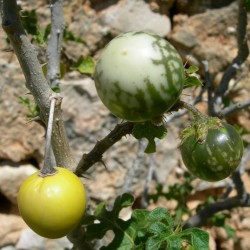
Ördögök alma magok (Solanum...
Ár
1,95 €
SKU: F 70
Seeds Gallery Com,
5/
5
<h2><strong>Ördögök alma magok (Solanum linnaeanum)</strong></h2>
<h2><span style="color: #fe0000;"><strong>Az ár a 10 db magot tartalmazó csomagra vonatkozik.</strong></span></h2>
<p class="">Az ördögalma vagy szodómia gyümölcs Dél-Afrikában őshonos. De megtalálható Ausztráliában, Új-Zélandon is. A növény bokros alakú, 0,5-1,5 méteresre nőhet. Az egész növény mérgező, bár gyógyászati célokra használják gyógyszerek előállítására és különféle betegségek kezelésére. Gyönyörű dísznövény, amely egész évben, késő őszig virágzik, és nem igényel gondozást, csak néha egy kis vizet…<br>It used to be called Solanum astrophorum, Solanum hermannii, Solanum mccannii, Solanum sodomeum, Solanum sodomeum var. hermannii, Solanum sodomeum var. mediterraneum, Solanum undatum, Solanum hermanii, apple of sodom, Afgan thistle, bitter apple, black-spined nightshade, poison apple and most commonly devil's apple or poison eggplant, with the accepted scientific name being Solanum Linnaeanum these days.</p>
<p>It is of African and Mediterranean origin but was introduced to Australia very early on with it being first collected and cataloged in Australia in the early 1880s.</p>
<p>It is a poisonous plant that is not eaten by anything as far as I can tell, except for the odd grasshopper which seems to become poisoned or drugged, sitting still in a stupor after a while. Handy in the greenhouse.</p>
<p>It is a spiky plant covered in straight needles which I find really cool. I love all the spiky Solanum, the same way some folks like Cacti I guess?</p>
<p>In Southern Africa, it has a long history of traditional use for skin conditions, toothache, cold and fever. Apparently the roots are carried as a talisman, for protection against poisoning.</p>
<p>It has long been used by pastoralists for skin disorders on the stock. Mashed and bound to the area needing treatment, or sliced and rubbed on regularly, its effectiveness where nothing else works is legendary.</p>
<p>Many folks swear by it, and there is a very popular "Devil's Apples Lotion" or "Poison Eggplant cream" made by blending the ripe fruit in olive oil then applying topically to the affected area.</p>
<p>I showed serious promise as a skin cancer treatment and in animal trials, it was shown to be very effective IN SOME CASES. Solamargine and solasonine are still being investigated as cancer treatment options in several places around the world. (There is a company in Vanuatu that currently sells a product under the name Curaderm BEC5, which is said to be effective, but it has not been approved for medical use by any regulatory agency.)</p>
<p>The big thing to remember in other cases it was just FATAL...</p>
<p>This is the reason the trials were discontinued, it wasn't because it didn't work, it's just that it killed and maimed a heap more critters than cancer would have statistically. Therefore it was not a safe or effective treatment in the majority of cases.</p>
<p>Like using a molotov cocktail to light your BBQ. Sure, sometimes it works great!</p>
<p>It is just unfortunate that you more often than not end up losing your eyebrows, blowing up your sausages, and setting fire to the neighbours clothesline...</p>
<p>The Pharmaceutical company most often quoted in regards to the effectiveness of this plant on cancer, Solbec, has since given up due to the variability in results and in 2004 they were fined for misleading shareholders and the public about the effectiveness of their drugs.</p>
<p>Solbec told the ASX, among other things, that Coramsine™ brought about total remission of malignant mesothelioma in mice when combined with immunotherapy. Following that announcement, the share price of Solbec increased by some 92 percent.</p>
<p>Solbec later told the ASX that the study had tested Coramsine™ on five mice of which only two had gone into remission of malignant mesothelioma. Solbec elected to comply with the notice. As provided under section 1317DAJ(3)(b) of the Act, compliance with the notice is not an admission of guilt or liability, and Solbec is not regarded as having contravened section 674(2) of the Act.</p>
<p>It is still under investigation for its effects on skin cancer, but it is a poison, and I do not recommend or encourage or advise use, application or ingestion in any way..</p>
<p>Folks don't do DIY chemotherapy, same theory.</p>
<p>It may kill you, or mangle you, just like it did to the mice.</p>
<p>In normal situations as a houseplant or a weed, poisoning is generally not a problem because the plant is rarely eaten, it is spiky and bitter, full of hard seeds and no really fruity flesh to it.</p>
<p>As a weed, it is easy to control as it rarely survives cultivation and its growth is quite slow for a Solanum species. The seeds can sit dormant in the soil for ages, but it is only in pastures this becomes a problem, and that is due to the cattle and sheep eating everything except the Devil's apple. Sensible grazing and occasional hand pulling is an effective control method.</p>
<p>Grasses will outcompete it, if given the chance, and they will block the light to dormant seeds meaning they never get the chance to germinate.</p>
<p>I grow this plant as an ornamental, and I sell the seeds only so you can do the same.</p>
<p>If your plans are to use this plant or its seeds for anything other than ornamental reasons, I humbly request you please bugger off now. Get it elsewhere, I don't need or want the drama your death or maiming could create.</p>
<p>It is a beautiful plant, and in my opinion, that is plenty of reason to grow it.</p>
<p>Like a bushy little rose, but big purple flowers and bright yellow fruits.</p>
<p>Does great in pots, germination takes about 6weeks normally, but it can be erratic. GA3 can often speed things up. Being a weed species it is not permitted to most places so pay attention to the big red text folks.</p>
<script src="//cdn.public.n1ed.com/G3OMDFLT/widgets.js"></script>
F 70 (10 S)






